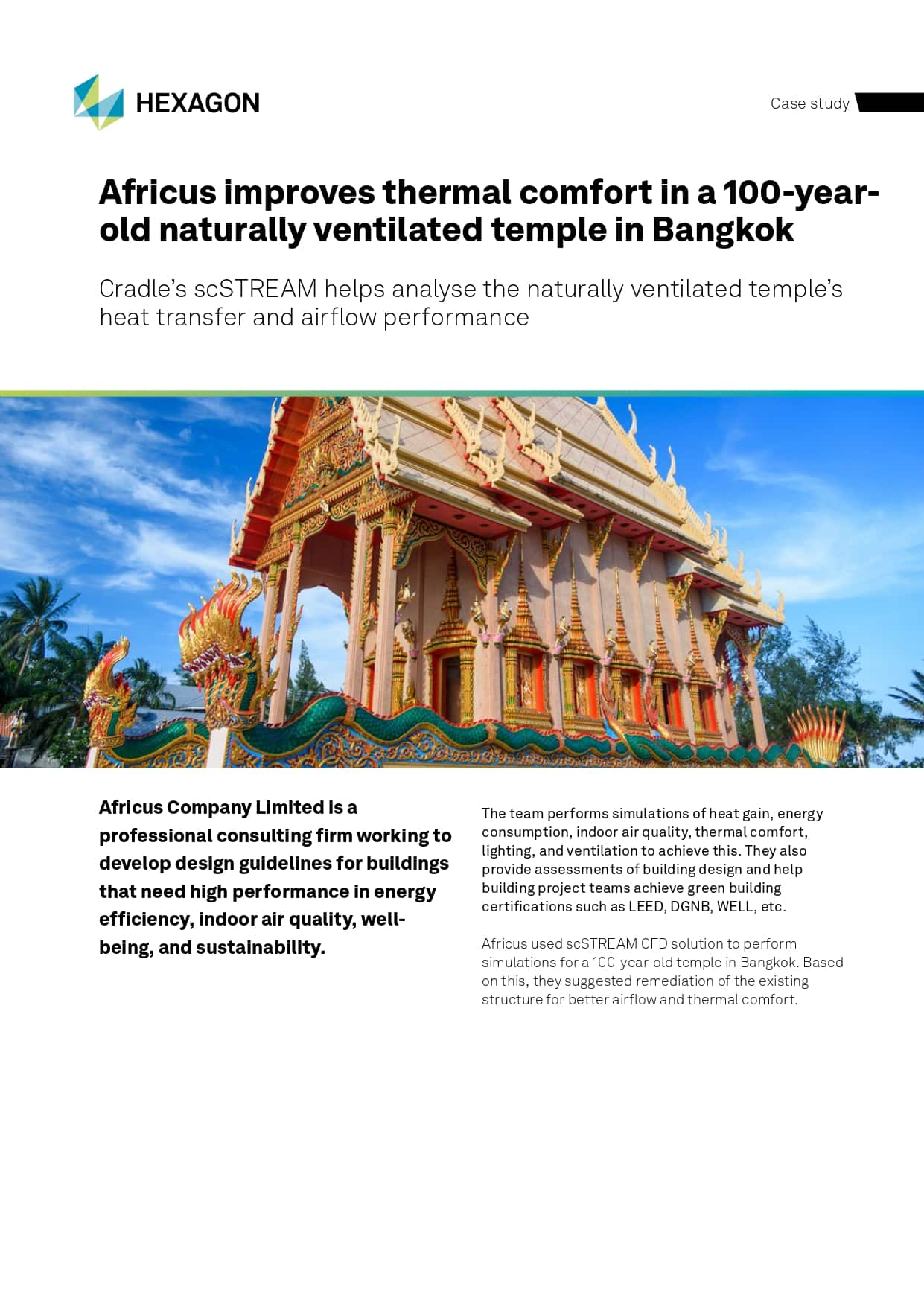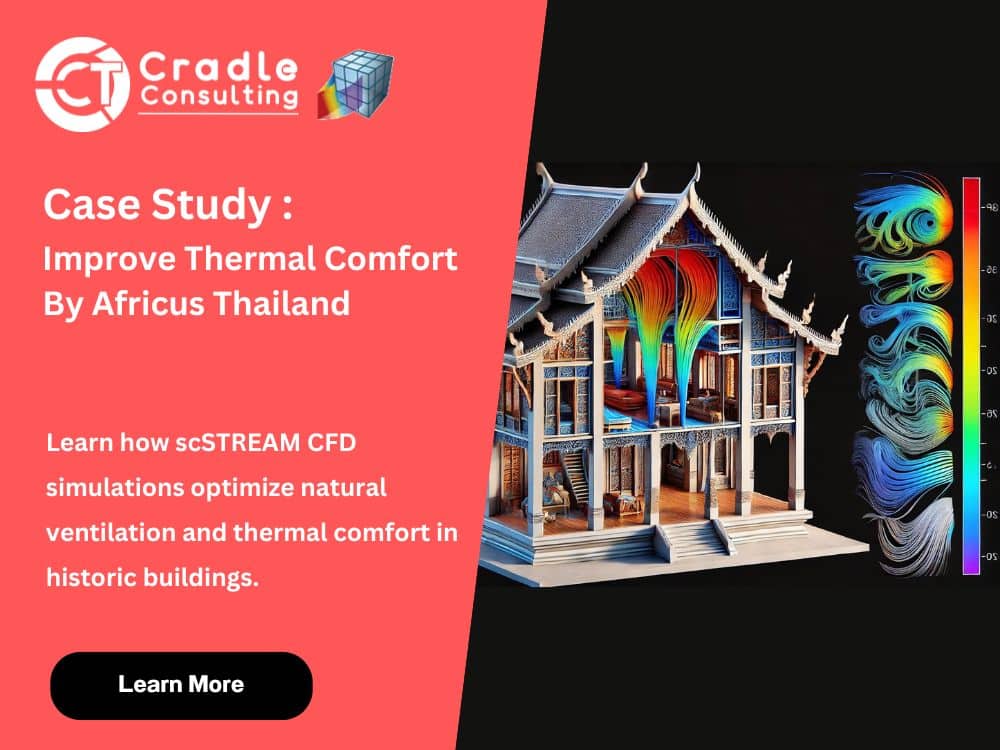When it comes to enhancing thermal comfort in naturally ventilated buildings, Computational Fluid Dynamics (CFD) tools are essential for precise airflow and heat transfer analysis. scSTREAM, a high-performance CFD solution developed by MSC Software, stands out for its ability to handle complex architectural designs while optimizing energy efficiency and indoor air quality.
Used by industry leaders for over 30 years, scSTREAM provides advanced simulations that guide architects and engineers in making data-driven decisions to improve building performance. Its ability to perform large-scale, high-speed simulations makes it ideal for analyzing the thermal comfort of urban structures, including naturally ventilated spaces like temples in hot and humid climates.

Table of Contents
Relevance of CFD in Structural Design
In modern architectural design, maintaining thermal comfort in buildings that lack air conditioning systems—such as historic temples—is a significant challenge. CFD simulations are critical for addressing issues such as heat retention, airflow blockages, and improper ventilation.
By simulating real-world conditions, scSTREAM allows design teams to:
- Optimize airflow through precise adjustments to building openings.
- Predict thermal comfort under various environmental conditions.
- Reduce energy consumption by using passive cooling strategies.
This is particularly relevant in regions like Bangkok, where temperatures often exceed comfortable limits. With the help of scSTREAM, architects can model airflow patterns and simulate temperature changes, enabling them to make informed decisions that enhance the well-being of building occupants.
In this case study, Africus Company Limited demonstrates the transformative potential of scSTREAM in a century-old temple in Bangkok, delivering solutions that improve indoor comfort while preserving the temple’s natural ventilation system.
Challenges in Naturally Ventilated Buildings in Hot Climates

Bangkok’s Climate and the Need for Thermal Comfort
Bangkok is known for its hot and humid climate, with temperatures often exceeding 30°C (86°F), especially during the long summer months. According to the World Meteorological Organization, the city ranks among the hottest globally in terms of average annual temperature. This presents a significant challenge for buildings that rely on natural ventilation rather than mechanical cooling systems.
In naturally ventilated structures, such as historic temples, maintaining indoor thermal comfort becomes increasingly difficult. These buildings often have high thermal mass, meaning that they absorb heat during the day and release it at night, resulting in uncomfortable indoor conditions even when outdoor temperatures drop. To ensure that such spaces remain comfortable for occupants, particularly during religious activities, it is crucial to carefully design the airflow and heat dissipation mechanisms.
Africus and the 100-Year-Old Temple Project


Africus Company Limited, a consulting firm specializing in energy-efficient design and sustainability, was tasked with improving the thermal comfort of a 100-year-old temple in the heart of Bangkok. The temple, built in an era before modern cooling technologies, was struggling to maintain comfortable indoor temperatures due to its reliance on natural ventilation.
Given Bangkok’s climate and the age of the building, Africus faced several challenges:
- Inadequate airflow inside the temple, leading to stagnant and stuffy conditions.
- Heat retention within the thick, high-mass walls, which kept the indoor environment hotter than the outdoor air, even at night.
- The need to preserve the temple’s historic architecture while implementing modern thermal comfort solutions.
By using scSTREAM CFD software, Africus was able to analyze the building’s airflow performance and heat transfer characteristics in detail, providing data-driven recommendations to enhance the temple’s indoor climate without compromising its architectural integrity.
The Role of CFD in Addressing Heat Transfer and Airflow

Key Challenges in Temple Design
The 100-year-old temple presented several design challenges related to airflow and heat retention. As a historic structure, the temple relied on natural ventilation with limited openings, which resulted in poor airflow. The thick, high-mass walls—designed to protect the building from outside elements—unfortunately contributed to heat retention, trapping warmth inside the temple throughout the day. This made the indoor environment uncomfortably warm, even during cooler evening hours.
Additionally, the religious spaces inside the temple, where most activities took place, experienced stagnant air due to inadequate ventilation. The accumulation of smoke from candles and incense further deteriorated the indoor air quality, creating a stuffy and uncomfortable atmosphere for worshippers.
Why Africus Chose scSTREAM
To overcome these challenges, Africus needed a high-performance CFD tool that could handle the complex airflow dynamics and heat transfer issues specific to large-scale, naturally ventilated buildings. scSTREAM was the ideal solution for this project due to its ability to perform:
- Accurate simulations of airflow and thermal comfort in and around large structures.
- Detailed analysis of heat retention and dissipation through different materials, such as the temple’s high-mass walls.
- High-speed calculations, making it efficient for real-time decision-making in large-scale projects.
Unlike other tools that were limited in scope, scSTREAM provided Africus with the flexibility to model intricate airflow patterns, enabling them to make data-driven recommendations for improving the temple’s ventilation.
Advanced Simulation Techniques Used by Africus

Combture of Energy-Efficient Bining scSTREAM with DOE-2
Africus leveraged the power of scSTREAM in combination with DOE-2, a thermal simulation program, to conduct a comprehensive analysis of the temple’s airflow and heat transfer. This hybrid approach allowed them to:
- Model the temperature distribution and airflow patterns throughout the temple.
- Compare real-world measurements of indoor air temperature with simulated results.
- Use Bangkok’s climate data to simulate how external environmental factors impacted the indoor conditions.
By combining these tools, Africus was able to simulate the steady-state thermal conditions inside the temple and identify areas where ventilation was lacking, making it possible to propose targeted improvements.
The Impact of CFD on Design Decisions
The CFD simulations performed by scSTREAM had a significant impact on the design recommendations for the temple. The detailed analysis revealed several key observations:
- Poor airflow in critical religious spaces, especially near the main altar, where worshippers gathered.
- Accumulation of smoke from incense and candles, which worsened the indoor air quality.
- High indoor temperatures, even higher than the outside air during certain times of the day, particularly at night.
These insights allowed Africus to make specific design interventions, such as adjusting the placement of ventilation openings, and recommending the installation of passive cooling features to improve airflow across the temple’s interior. This approach not only enhanced the thermal comfort but also addressed the air quality issues, creating a more pleasant environment for the temple’s visitors.
Proposed Design Improvements

Recommendations Based on scSTREAM Simulations
The scSTREAM simulations provided valuable insights into how the temple’s airflow and thermal comfort could be significantly improved without compromising its historic integrity. Based on the results, Africus recommended the following design improvements:
- Low-absorptivity roofing: The existing temple roof absorbed a large amount of heat during the day, contributing to high indoor temperatures. By using low-absorptivity roofing materials, the temple could reflect more solar radiation, keeping the interior cooler throughout the day.
- Ceiling insulation: Insulating the ceiling would prevent heat transfer from the hot roof into the temple’s interior spaces, maintaining more stable indoor temperatures and improving overall thermal comfort.
- Ventilation strategies to improve airflow: The simulations revealed that airflow was insufficient in certain areas of the temple, particularly near the main religious spaces. Africus proposed increasing the size of ventilation openings and optimizing their placement to allow for better cross-ventilation, improving air movement through the temple.
- Solar shading and night ventilation strategies: To further reduce heat gain during the day, solar shading structures were suggested to block direct sunlight from entering the temple. Additionally, implementing night ventilation would help remove heat that had built up during the day, cooling the temple naturally overnight.
Results of Implementing the CFD-Driven Changes
Comparison Between Old and Prototype Temple Designs
The implementation of these CFD-driven improvements had a dramatic effect on the thermal comfort inside the temple. The simulations indicated that after applying the proposed changes, the temple’s indoor temperature could be reduced by as much as 4.5°C on a typical summer day.
- In the old temple, the indoor temperature often exceeded the outdoor temperature, particularly at night, due to the high thermal mass of the building materials.
- In the prototype design, the combination of improved ventilation, low-absorptivity materials, and insulation led to a more consistent and comfortable indoor environment, with lower temperature fluctuations and more effective heat dissipation.
These changes not only improved the comfort of the space for visitors but also addressed issues like smoke accumulation by improving air circulation within the temple.
Long-Term Benefits of scSTREAM in Design
The long-term benefits of using scSTREAM in building design are substantial. By providing detailed airflow and thermal simulations, scSTREAM helps architects and engineers make informed decisions that lead to more energy-efficient and comfortable structures. The tool’s ability to simulate real-world conditions means that design improvements can be made early in the planning stage, reducing the need for costly retrofits or reliance on mechanical cooling systems.
For projects like the 100-year-old temple, scSTREAM enabled the creation of passive cooling solutions that drastically reduced the indoor heat without installing air conditioning. This not only preserved the historic integrity of the temple but also ensured that it remained comfortable for its occupants, even in Bangkok’s hot climate.
In conclusion, the use of scSTREAM allows for the development of sustainable and cost-effective design strategies that enhance thermal comfort while maintaining the environmental and cultural values of the building.
Why Choose scSTREAM for Building Design Projects?
Advantages of scSTREAM in Architecture
When it comes to designing buildings that require optimal thermal comfort and energy efficiency, scSTREAM offers several key advantages that make it the ideal choice for architectural projects:
- Large-scale simulation capabilities: scSTREAM is equipped to handle complex simulations of airflow and heat transfer in large-scale buildings, making it perfect for projects that involve historic structures or naturally ventilated spaces. Its ability to model the entire environment surrounding the building ensures that no aspect of the airflow or heat distribution is overlooked.
- Easy integration with other programs like DOE-2: scSTREAM’s seamless integration with other simulation tools, such as DOE-2, allows for a comprehensive analysis of both thermal performance and energy consumption. This makes it easier to address multiple aspects of a building’s design in one cohesive workflow, reducing the need to switch between different programs or create new models from scratch.
- Accuracy in predicting real-world thermal conditions: One of scSTREAM’s most significant advantages is its ability to produce highly accurate simulations that closely mimic real-world conditions. Whether it’s modeling the impact of high-mass walls in a temple or predicting how ventilation changes will affect indoor airflow, scSTREAM provides reliable data that architects can use to make informed decisions.
By utilizing these strengths, scSTREAM enables architects and engineers to create designs that not only meet comfort requirements but also reduce energy usage, ensuring buildings remain both sustainable and cost-efficient.
Conclusion
The Future of Energy-Efficient Building Design with scSTREAM
As the demand for sustainable and energy-efficient buildings continues to grow, tools like scSTREAM are becoming essential in tackling the challenges posed by hot and humid climates like Bangkok. Its ability to simulate complex thermal dynamics and airflow patterns makes it invaluable for improving the comfort and performance of naturally ventilated buildings, such as historic temples.
By integrating CFD analysis early in the design process, architects can optimize their projects for long-term sustainability, reduce reliance on mechanical cooling, and create environments that are healthier and more comfortable for occupants. scSTREAM offers a path forward for building professionals who aim to design spaces that align with both environmental goals and cultural preservation, ensuring that the future of architecture is both innovative and sustainable.
Reference
- Africus Improves Thermal Comfort in a 100-year-old naturally ventilated temple in Bangkok – Hexagon CaseStudy
Download this article

About scSTREAM

scSTREAM thermo-fluid software has been a trusted tool in the electronics and architectural industries for over thirty years. The software is renowned for its user-friendly interfaces and high-speed processing. HeatDesigner, based on scSTREAM, is specially developed for the thermal design of electronic products, offering necessary physical functions with a simple interface and powerful computing performance.

